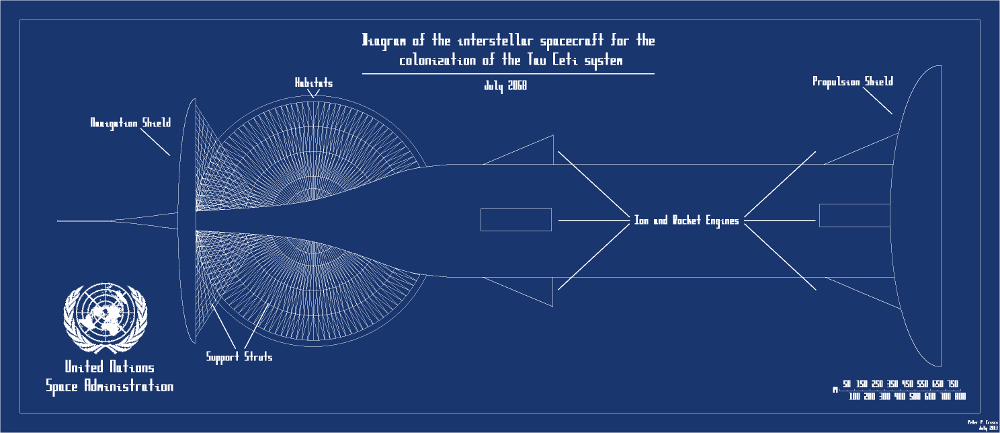The Mothership
Original diagram of the mothership

Image courtesy of the National Museum of Peteria.
Click the image to enlarge.
Original diagram of the mothership

| This vessel is humanity's first interstellar spacecraft, designed for the colonization of the Tau Ceti system. Habitable space is provided by two rotating rings, in which centrifugal force creates the sensation of gravity on the insides of their outer circumferences. To stabilize the ship against their motion, the rings rotate in opposite directions. A dome at the bow, the navigation shield, protects the ship from impacts with debris in space while moving ahead. A dome at the stern, the propulsion shield, takes the force of the nuclear detonations that propel the ship and also acts as a debris shield when the ship turns around to decelerate. The front third of the hull mainly contains cargo holds, hangars, food production, and water and oxygen storage. There are also several zero-g recreation rooms. The rear two thirds of the hull contain almost entirely fuel. As of 2590, the ship is in a decaying orbit around the planet Tau Ceti a in the Tau Ceti system. At its current rate, the ship is expected to impact the planet before 2610. |
| Home Port | Mid-Pacific Space Dock, Earth |
| Operator | United Nations Space Administration |
| Year Commissioned | 2094 |
| Cost | approx. $19.3 trillion |
| Length | 5,667.04 m |
| Beam | 482.62 m (at midship) |
| Height | 1,932.09 m (max.) |
| 723.73 m (at midship) | |
| Mass | approx. 3.109 × 1010 kg, the same as about 300 aircraft carriers |
| Max. Speed | 0.67 c |
| Auxiliary Vessels | 40 transport shuttles (only two known to be intact) |
| Propulsion | Nuclear pulse propulsion system and ion engines provide the thrust for interstellar travel. Ion engines and chemical rockets are used for maneuvering and for travel within star systems. |
| Electricity production | Power for the ship's systems, other than propulsion, is provided by seven nuclear reactors with a combined maximum power output of 11,576 MW. |
|
|
|
| Position | Side by side at the bow of the ship |
| Diameter of Each | 1,609 m (1 mi) |
| Width of Each | 100 m |
| Height of the Habitable Area in Each | 40.93 m |
| Number of Decks in Each | 10 |
| Total Habitable Space | 9.42 km2 |
Click here to return to the homepage